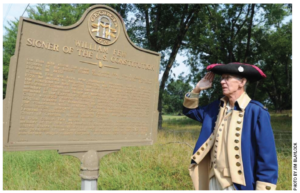IT SEEMS LIKE THE EVANS TOWNE CENTER COMPLEX popped up almost over night. Newcomers quickly discover how indispensable it is to Columbia County. It’s the hub of activity, drawing residents to its amenities. The government offices, the library, the park, the amphitheaters, the performing arts auditorium, the playgrounds and the businesses being established around Evans Towne Center draw a spectrum of users. It sparkles with newness.
Progress is an inevitable necessity in the face of the monumental growth of Columbia County over the past decades. And it brings benefits. Grovetown, Evans, Martinez and Harlem are listed among the top places in to live in Georgia (http://www.areavibes.com/best-places/georgia).
The population explosion has spurred construction of neighborhoods and schools, inspired entrepreneurs and attracted major corporations.
But Columbia County has another face, an older face with tales to tell. Humans inhabited it before Europeans began domesticating its wildness. Instead of sprawling with subdivisions, the land rambled across untamed forests and fields. Undammed, the Savannah River whooshed between banks hidden in tangles of trees and vines. Seeing merit in its soil, white men arrived here and put beast-drawn plow to earth.
As the county has moved away from its agrarian roots, folks sometimes lose sight of what preceded modern days of abundance. “We’re growing so fast and there’s so much that’s new,” says Columbia County Commissioner William Morris. “If we’re not careful, we can outgrow ourselves.” He hopes that the initiative dubbed Project 225 will bring the county’s history into perspective for a new generation of visitors and citizens.
December 10, 2015, will mark Columbia County’s 225th anniversary. In 1790, the Georgia Legislature established Columbia County, parceling it out from Richmond County and including within its borders much of what later became McDuffie County. This area, originally inhabited by primitive Native Americans, settled by Quakers and named for Christopher Columbus, has developed into one of Georgia’s booming economic centers. The county’s leaders, appreciating its growth and its potential, embrace both its storied past and its promising future.

Project 225, the brainchild of Randy DuTeau, executive director of Columbia County’s Convention and Visitors Bureau (CCCVB), rolls out this year to coincide with the county’s birthday.
Project 225, the brainchild of Randy DuTeau, executive director of Columbia County’s Convention and Visitors Bureau (CCCVB), rolls out this year to coincide with the county’s birthday. “It has become a passion project,” he says. “It’s created a lot of buzz.” The goal is to capitalize on digital technology to bring history out of the past and put it at the fingertips of citizens, visitors, educators and new residents. “We can’t wait to share the story,” DuTeau says.
Last summer, Commissioner Morris’s son, who lives in Athens, sent him a blurb about a city’s heritage tour. Morris, who embraces an enthusiastic interest in history, shared the media item with DuTeau, who works daily at marketing Columbia County’s features and attractions. The idea of compiling the county’s heritage resonated with him. “We put our heads together and said let’s do this,” Morris says. “We’re trying to drive people to explore the county.”
History and heritage tourism is a trending niche in the travel industry. It nourishes people’s hunger to see the sites, learn about the personalities and events, and participate in the activities that give a locale its identity. They desire to come away knowing what it means to be a resident of a particular place, to understand the affairs that fashioned it. DuTeau, working with the CCCVB board, has allocated funding to promote Columbia County’s history and cultural heritage. Project 225 taps into that type of curiosity in order to serve that variety of tourist.
Heritage tourism draws in outsiders, encourages commerce and increases the stores of county coffers. Active development of heritage tourism meets another need, as well. It improves and increases the wealth of recorded historical information unique to a particular city or county. It promotes preservation of the sites important to it. When residents gain knowledge about where they live and the forces that influenced it over the centuries, they take ownership of it. It becomes more than just the location of their house and their workplace. It becomes home, a place to protect, nurture and welcome outsiders. Project 225 will give citizens talking points
for sharing what’s special about Columbia County.
DuTeau says, “The most important thing is that we capture the information.” He and the project partners, which include the CCCVB, the Columbia County Historical Society, the Columbia County Historic Property Advisory Committee and the Columbia County Board of Commissioners, wish to honor all who shaped the county’s past and thus its present and its future. “We’re being mindful of all the content,” he adds.
Project 225, the brainchild of Randy DuTeau, executive director of Columbia County’s Convention and Visitors Bureau (CCCVB), rolls out this year to coincide with the county’s birthday.

In October 2014, DuTeau pitched the Project 225 idea to the Columbia County Historical Society. The organization swung its support behind DuTeau’s effort. “The first thing we did was recommend some existing historical markers to start with,” says Rob Nordan, historical society president. A few additional sites pulled from a brochure compiled by the Historical Society about 20 years ago were added to the list. This handful of sites will be the first highlighted by the project. Some 38 sites significant to the county’s history are identified in the Historical Society brochure, but rapid land development and natural dilapidation of structures over time have rendered some of the places lost. Project 225 brings to the forefront a portion of what remains and hopefully will inspire new pride in preserving the past.
Well-known landmarks, such as the Appling Courthouse, will grace the inaugural incarnation of Project 225. The oldest Georgia courthouse still in use, the Appling Courthouse is situated in Columbia County’s 19th-century center of social life. Constructed in the early 1800s, it was listed on the National Register of Historic Sites in 1980. Likewise, the project will introduce visitors to Kiokee Church, recognized as the first Baptist Church in Georgia, pre-dating the Revolutionary War. υ
Project 225 will also reveal that William Few isn’t just the name of a parkway running through Columbia County. William Few was a member of the Continental Congress. Following the Revolutionary War, he proudly put his signature on the newly composed United States Constitution. He was among the original trustees for establishing the University of Georgia. A marker on Cobbham Road indicates the location of William Few’s home that unfortunately burned in 1930.
Less familiar but equally important people have found their way into the project too. Basil Neal, for example, a Revolutionary War soldier, will be part of the lineup. He is commemorated with a marker on Cobbham Road. It indicates the location of his burial place and his home site, which he named Happy Valley. The father of 12 children, many of his descendants still live in the area.
The old Native American Indian trail traced by the last 20 miles of U.S. 278, which runs through Harlem, will be featured also. The Upper Trading Path and its branches facilitated access to tribes in North Georgia, Alabama and as far west as the Mississippi River. In the early 1700s, European traders began traversing this path that continues as a modern thoroughfare.
Additional Project 225 entries include poet Paul Hamilton Hayne, who made his home at Copse Hill near Grovetown, and comedian Oliver Hardy, who was born in Harlem and enjoyed fame as part of the Laurel and Hardy duo. The churches of Shiloh Methodist, Damascus Baptist, Sharon Baptist, White Oak Church and White Oak Tabernacle, each with its own particular contribution, will be included. Sites along the Savannah River, like the Augusta Canal Gatekeepers Cottage, Stevens Creek Dam and Stallings Island round out the collection.
A photographer has captured current images and the CCCVB has compiled old photos and other information documenting the importance of each of these locations. During this first phase of the project, a page on the CCCVB website, www.ColumbiaCountyItsHere.com, will host these materials. A click on the added history tab will take users to pictorials
and narratives.
DuTeau’s step-by-step process for bringing Project 225 to fruition is deliberate and systematic. Accuracy, presentation and usability are priorities. Ensuring that all sides of the story are told in an enticing and compelling format trumps speed to market. DuTeau is also cognizant that the presentation platform must be eye-catching and attractive in order to prompt users to click through. Thus, as excited as he is about putting the final product in consumers’ hands, he’s willing to work at a pace that allows time to detect glitches and get it right. “We need to take the long view on the project,” he says. “We just want to ensure that this first phase is done well. It’s really important to contain the enthusiasm and be smart about developing and rolling out the project.”

“Projected completion of the cultural center is 2022, which provides ample time for Project 225 to ramp up, develop its layers and generate community pride.
Nonetheless, eagerness is just what drives this project forward. “We have so many different directions we can take this, so many places we can share this,” says DuTeau. Extensive possibilities and evolving technology mean that the door remains always open to adding fresh content, manipulating it for functionality on mobile devices and capitalizing on alternative modes for staging it. He envisions the second phase of Project 225 dedicated to media campaigns and public relations outreach. Phase three will move the information to other technologies and digital platforms. DuTeau says, “This may include podcasts, video vignettes, drone video tours of protected locations and video interviews.” Tours and special events will likely spring out of Project 225 down the road as well.
With SPLOST money for a cultural center approved, inclusion within that building of a museum to archive and curate pieces from Columbia County’s history will complete the circle begun by Project 225. “People can feel comfortable donating artifacts,” says Commissioner Morris. “I hope people who are interested will come forth and share whatever they have.” Projected completion of the cultural center is 2022, which provides ample time for Project 225 to ramp up, to develop its layers and to generate notice and community pride.
But again, DuTeau plans to move forward slowly, vetting the information acquired at each step, creating an appealing digital platform on which to present it, adding elements and strata as Project 225 progresses. Though a soft launch will likely occur within the next months, DuTeau plans to officially unveil his work at the county’s 225th year celebration slated to be held on December 10th at the courthouse in Appling.
Entangled in the county’s agrarian roots are great thinkers, accomplished doers, trailblazers, tribes and average people who called the area home and who went about the business of life much as we do today. Project 225 will cast a spotlight on politicians, poets, preachers, founders, settlers, first inhabitants and entertainers who not only hailed from the county, but shaped it, the state and the nation. It will aid appreciation anew of every corner contained within its boundaries. The stories of fields and streams and creeks and forests and neighborhoods and streets and roads encountered by residents every day will be claimed, told and retained.
This article appears in the April 2015 issue of Augusta Magazine.






